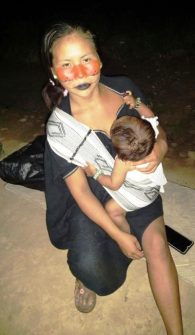Bolivia. Elegance in traditional Chacobo dress.

The Chacobos are an indigenous people living on the banks of the Benicito River in Northeastern Bolivia. Let’s get to know them
through their clothing.
The clothing of the Chacobos is made with material that Mother Nature gives them, mainly strips of bark from leafy trees. They like to adorn themselves with seed bracelets.
Chacobo women, when they go to visit another Chacobo village or during festivities, wear a strip of tufts of feathers at the top of their arms. Another important item to them is the bead necklace. A well-dressed woman is one wearing necklaces with several rows of brightly coloured beads, coins, and small pendants. They say that in the past, Chacobo women used to wear seed bead necklaces only, but now due to the influence of modern culture, they like wearing also other ornaments, which they buy in urban areas. According to them, beads are a symbol of elegance and prestige. That’s why every woman wants to wear more bead rows than the others, showing this way, greater prestige.

The Chacobo women paint geometric patterns onto their skin using urucú (the bright red crushed seeds of achiote) and a dye made from genipa, the berry of a species of genip tree. File swm
On special occasions such as parties or when they visit other Chacobo villages, they can also wear a circular headband made of red toucan feathers. If a woman does not have a headband, then she sticks some feathers to her hair with glue, near the crown of her head. The Chacobo women paint geometric patterns onto their skin using urucú (the bright red crushed seeds of achiote) and a dye made from genipa, the berry of a species of genip tree. They sometimes just dye their skin without drawing any pattern, some of them do so just to adorn their skin, others think that the black dye repels insects, blocks sun’s rays, and prevents diseases.
According to their oral narrations, once, women used to pierce their nasal septum at puberty and insert a tuft of red toucan feathers. They even used to pierce their nostrils to insert a wooden ball into those two small holes. Currently, these customs no longer exist, since many women died from infection. In times of mourning, the women of this ethnic group have the custom of removing their necklaces and other ornaments for up to a year. Another Chacobo tradition is giving a newborn baby a bead necklace or small trinkets as a gift. The bead row is put around the neck or wrists of the baby. The typical clothing for the Chacobo men is a loose ankle-length robe made of strips of bark in the shape of a poncho with a slit in the middle for the head and armholes. This robe is similar to the kushama of the Asheninkas of Peru. They use a cotton pita belt to cover their private parts. Their ankles, calves, wrists, and arms are wrapped with strips of bark. The strips on the wrists serve as protection while shooting arrows. The Chacobo men wear a headdress consisting of fibrous strips of bark covered with the silky plumage of ducks from which tassels of toucan bright scarlet- and yellow-coloured feathers hang. There can be between 100 and 200 tassels of feathers on a single headdress, which is also adorned with small pieces of broken mirrors, beads, and other decorations.

The Chacobos use their traditional colourful clothing only on very special occasions. File swm
In addition, some headdresses include a tassel of feathers tied at the back. This type of headdress consists of ten red and light blue tail feathers of macaw with a cluster of 12 oriole feathers. The tips of the two outer feathers droop under the weight of the tassel made from the silky plumage of ducks from which a few oriole feathers hang, which are all yellow except the two in the centre that are black. Behind the macaw feathers there are 30 or so chicken tail feathers, set near the bottom of the headdress. The woven sashes tied to the arms are decorated with bright yellow feathers. Chacobo men also wear long threads covered with the plumage of ducks. The arm girdles are decorated with various ornaments such as seeds and bones.
Just like the women, men use these bands at parties or when visiting other Chacobo groups. But some of them admit that they enjoy wearing these decorations also when they are at home. When not working, they like to sit in the meeting hall, chatting while adorned with bright feathered headbands and armbands.
However, modern fashion has also reached this community by now. The Chacobos use their traditional colourful clothing only on very special occasions such as parties and other special events.
Jhonny Mancilla Pérez



